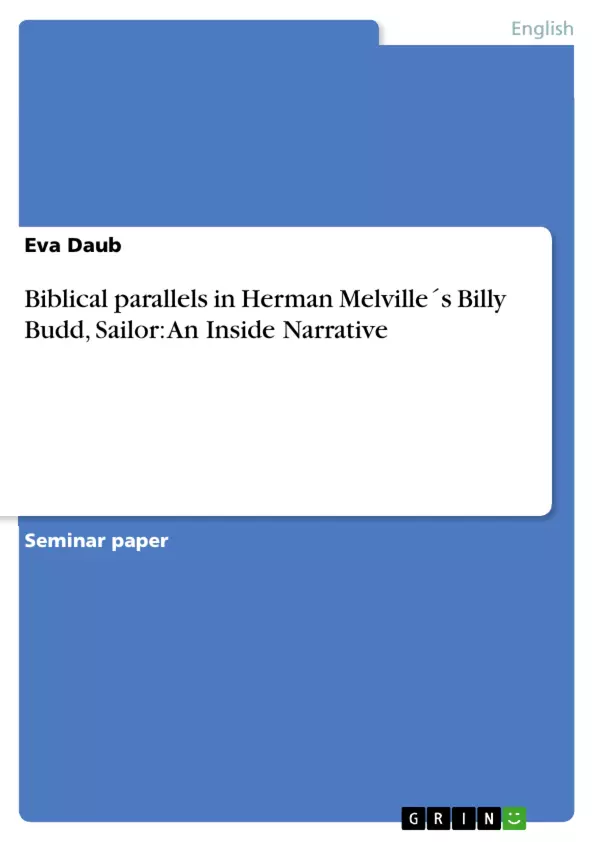Biblical parallels in Herman Melville´s Billy Budd, Sailor: An Inside Narrative
Herman Melville was one of the most famous American writers during the 19th century. To him we owe one of the best known classical pieces of literature: Moby Dick.
Billy Budd, Sailor: An Inside Narrative was the last of his works to be published in 1924. Until today critics could not reach agreement on a common interpretation of this short-story, written by Melville both in prose and in verse. And it is certainly true that you can read it on a number of different levels. Some see the piece as an examination of society which brings together embodiments of various political philosophies in Melville’s final comment on the place of good and evil in modern civilization. Others relate the short novel to a spiritual autobiography of Melville himself. In the following I would like to focus on the story as a parallel to the epic Christian battle between good and evil with examples of biblical allusions that were used by the author.
[...]
Inhaltsverzeichnis (Table of Contents)
- Biblical parallels in Herman Melville's Billy Budd, Sailor: An Inside Narrative
- The Story as a Parallel to the Epic Christian Battle between Good and Evil
- Billy Budd: The Innocent Sailor
- John Claggart: The Depraved Enemy
- Captain Vere: The Conflicted Lieutenant
- The Scene of Bribery
- The Situation Escalates
- The Sacrifice of Billy Budd
- The Heroic Image of Billy Budd
- Billy's Death: A Parallelism to the Crucifixion of Jesus
Zielsetzung und Themenschwerpunkte (Objectives and Key Themes)
This essay aims to explore the biblical parallels woven into Herman Melville's Billy Budd, Sailor: An Inside Narrative, showcasing how these allusions contribute to the story's enduring significance and elevate it beyond a mere maritime tale.
- The eternal struggle between good and evil
- The nature of innocence and its vulnerability to corruption
- The complexities of justice and the tension between individual conscience and institutional duty
- The enduring power of sacrifice and its impact on the human condition
- The lasting legacy of heroic figures and the transformative power of their narratives
Zusammenfassung der Kapitel (Chapter Summaries)
The essay begins by establishing the context of Melville's work within the broader framework of American literature, highlighting the ambiguity surrounding its interpretation. It then delves into the central characters, drawing parallels between Billy Budd, John Claggart, and Captain Vere, and their respective biblical counterparts: Adam, the Serpent, and God.
The analysis focuses on the portrayal of Billy Budd's innocent nature, emphasizing his inherent goodness and the divine qualities attributed to him by Melville. This is contrasted with the malicious and manipulative nature of Claggart, who embodies the serpent's temptation and embodies the forces of evil.
The essay explores the scene where Claggart attempts to bribe Billy, further solidifying the biblical allegory by portraying Claggart as a serpent seeking to corrupt an innocent soul. The conflict escalates when Claggart falsely accuses Billy, leading to a tragic confrontation where Billy's inability to articulate the truth results in the death of Claggart.
The essay then delves into the character of Captain Vere, highlighting his internal struggle as he must balance his love for Billy with his duty to uphold the law. The author draws parallels between Vere and Abraham, the biblical patriarch who was tested by God through the demand to sacrifice his son.
The final chapters focus on the impact of Billy's death, particularly for the crew who mourn him as a martyr. The essay emphasizes the enduring legacy of Billy's sacrifice and the symbolism associated with his tragic end.
Schlüsselwörter (Keywords)
Key terms and concepts explored in this essay include: biblical allusions, good vs. evil, innocence, corruption, justice, duty, sacrifice, heroic figures, and enduring legacy.
- Arbeit zitieren
- Eva Daub (Autor:in), 2001, Biblical parallels in Herman Melville´s Billy Budd, Sailor: An Inside Narrative, München, GRIN Verlag, https://www.hausarbeiten.de/document/3283


